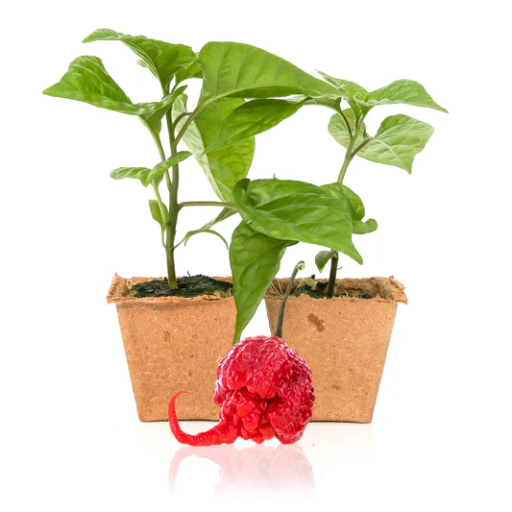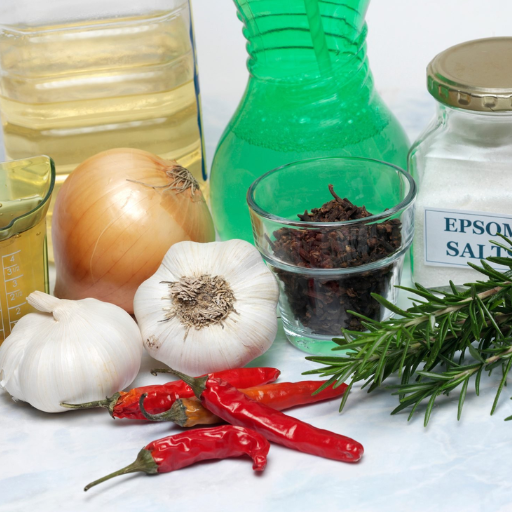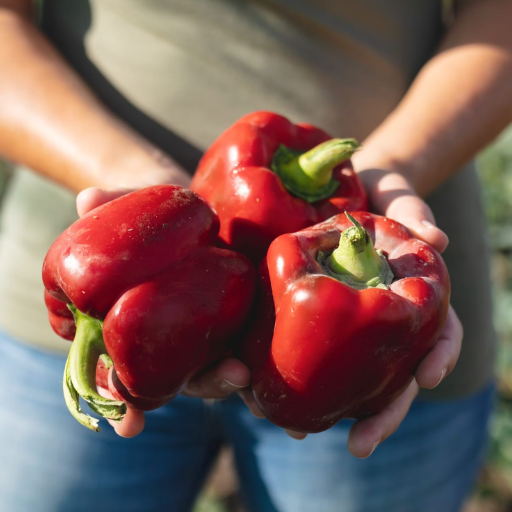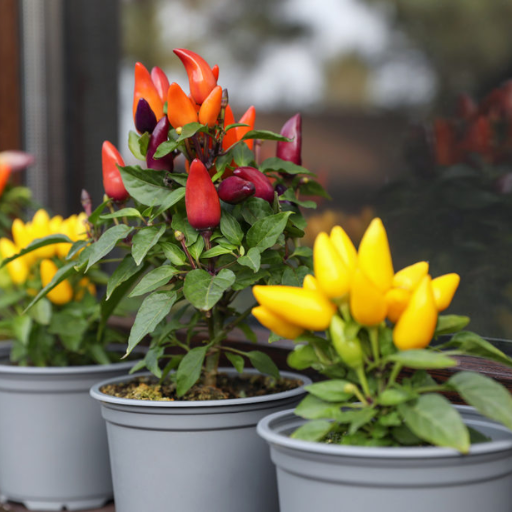To grow strong and lush pepper plants, much care must be given and the proper nutrients supplied. Many growers neglect Epsom salt, yet it is one of the most beneficial substances for supporting these plants since it contains magnesium and sulfur, two essential nutrients that can significantly promote crop development and yield. This article will discuss the role of Epsom salt spray in enhancing nutrient intake through leaves/fruit, changing fruit quality for the better, and giving an army against common plant diseases. We will also provide step-by-step directions on how to make your solution using Epsom salts, application tips, and best practices to ensure thriving pepper plants. With this guide, experienced gardeners and amateurs will learn how to raise healthy, productive peppers.
What is Epsom Salt, and Why is it Used for Pepper Plants?

What are the advantages of using Epsom salt?
Epsom salt is beneficial to pepper plants. To begin with, magnesium in Epsom salt plays a crucial role by increasing chlorophyll production, which enhances photosynthesis and overall plant health. Secondly, it increases the absorption of other essential nutrients, such as nitrogen and phosphorous, hence enhancing growth and fruit development. Lastly, Sulphur plays a vital role in amino acid formation and helps to make strong cell walls that protect against pests and diseases. In this regard, Epsom salts can be used in the routine maintenance of pepper plants leading to healthier yields.
How does epsom salt improve plant growth?
The first way that Epsom salts increase plant growth is through their high magnesium content (about 9.8% by weight), which acts as the building block for chlorophyll formation, which is necessary for capturing sunlight energy during the photosynthesis process. This leads to increased growth rates, resulting in improved foliage vigor.
The second one is Sulphur (about 13% by weight). It has an essential function regarding amino acid formation—organic compounds needed for protein synthesis, thus promoting general health and resilience among different plants. Doing so makes it possible for nitrogen and phosphorus uptake from the soil improving their availability when epsom salts are applied.
Evaluating these parameters shows that magnesium improves nutrient use efficiency, while sulfur promotes growth and makes plants more resistant to adverse environmental effects. Therefore, if these important processes are facilitated, Epsom salt can significantly boost pepper plant productivity.
What is the significance of magnesium concerning plant health?
In my study on the role played by magnesium in maintaining healthy plants, I discovered that it was an essential macronutrient whose presence greatly influenced crop vitality [7]. It is one of the main constituents of chlorophyll, the pigment responsible for photosynthesis, enabling plants to make sunlight energy into usable body fuel. Plants without enough magnesium often have yellow leaves and stunted growth due to poor photosynthetic function. Besides, magnesium helps in the activation of some enzymes required for carbohydrate and protein synthesis, thereby promoting general plant development and resilience. Furthermore, it has been observed that magnesium improves the absorption of other nutrients, such as nitrogen and phosphorus, leading to a balanced nutrition profile required for the robust growth of plants [14]. Thus, without these minerals, healthy green plants cannot be maintained.
How to Apply Epsom Salt Spray on Pepper Plants

What is the best way to mix Epsom salt with water?
First, I measure one tablespoon of Epsom salt to make an effective Epsom salt spray for my pepper plants. The final step I carry out is adding this into a clean gallon of water so that the salt dissolves completely. Finally, mixing the mixture well until epsom salt gets fully integrated is recommended. After mixing this solution, I put it into a pump bottle to easily spray the crops’ leaves. This spray is applied every few weeks throughout the growing season to maintain magnesium and sulfur at optimal levels for healthy, productive plants.
What does foliar spray application do?
When applying foliar sprays, it would be better to do this in the early morning or late evening to avoid direct sun, which can scorch up leaves. Once again, I ensure that there are no dust particles on the plant’s leaves so they may easily take in nutrients. Additionally, while spraying, I would preferably hold the bottle around 12-18 inches above those leaves and mist evenly across their surfaces, especially on the undersides since they contain stomata(Forbes et al., 2012). For instance, when plants are dry or almost dry before being sprayed over-saturation, it should be avoided because if one happens to overspray, the disease might occur. This method optimizes nutrient uptake and encourages healthier plant growth
How often do you use epsom salt on hot pepper plants?
Epsom salts are usually once spread over my pepper crop every three to four weeks during its growing season. These timings ensure a proper balance of magnesium (Mg) and sulfur (S) to promote the well-being of plants and improve good fruit production. If any signs indicating nutritional deficiencies like yellowing leaves are seen, then sometimes, instead of doing it occasionally(I may adjust the frequency by a little bit), it might be necessary to increase the number of times I use epsom salt since they absorb such minerals efficiently. Regular monitoring ensures optimum growth and yield of my hot peppers.
Understanding the Nutrient Needs of Pepper Plants

What is the significance of magnesium to pepper plants?
Pepper plants’ well-being and productivity are highly reliant on magnesium. As a crucial component of chlorophyll responsible for photosynthesis, it is vital to the plant’s capacity to convert sunlight into energy. Suppose there is an insufficient amount of magnesium. In that case, plants can show symptoms like interveinal chlorosis, where yellow appears between leaf veins. In contrast, the veins develop green, affecting their overall growth and reducing fruit yield.
My research from reliable sources indicates that soil should have an appropriate magnesium level for pepper plants, typically ranging from 50 ppm to 100 ppm (parts per million). Hence, this was justified by studies that revealed if magnesium levels remain within this range, photosynthesis becomes more effective, and cell walls are more robust. It has been observed that optimal root development and improved fruit quality can be achieved when enough Mg exists in the soil (Evensen et al., 2021). Additionally, it aids nutrient uptake since other essential elements, such as nitrogen and potassium, will be taken up efficiently. Overall, providing adequate amounts of magnesium becomes critical for achieving maximum health for the pepper plants and their fruits.
How would I identify magnesium deficiency in plants?
Is it possible to find out whether my plant has a magnesium deficit? There are specific symptoms on leaves that I usually look at when trying to establish whether my crops have a deficit regarding this vital macronutrient element. Initially, older leaves start with interveinal chlorosis, which means they turn yellow while veins remain green. This yellowing often starts with older foliage since Mg mobile within the plant typically gets used up more rapidly by new growth, necessitating such uptake from old leaves to support new ones. In addition to these signs above, I also observe curled or mottled leaf edges, whereas severe cases may have necrotic spots on leaves that ruin entirely them. In such cases, I quickly test the soil for magnesium levels and possibly propose a suitable magnesium supplement that could help rectify the imbalance and support healthy plant growth.
Can epsom salts be used on tomatoes and peppers?
Yes, I can use Epsom salt on tomatoes and peppers. Magnesium sulfate, or what is commonly known as Epsom salt, provides an additional source of magnesium, which can be beneficial to these plants, particularly if there are indications of its insufficiency. It has been my experience that by applying Epsom salt, nutrient uptake is improved while, at the same time, there is the general improvement in plant health, leading to quality fruits and good yields. For a start, during growing season (especially when flowering or fruiting) dissolve about one tablespoonful of Epsom salt into a gallon of water for spraying over foliage. This practice not only helps with magnesium levels but can also encourage a bushier plant structure and increase the size of the fruit.
Common Mistakes in Using Epsom Salt in the Garden

What are the consequences of using too much epsom salt?
Applying too many Epsom salts in my garden can cause several problems. An overabundance of magnesium also disrupts the balance of soil nutrients, leading to deficiencies in other essential minerals such as calcium and potassium, thus negatively affecting plant health. Moreover, I discovered that excessive application causes salt accumulation around roots, making it harder for plants to uptake water. Therefore, following recommended dosages is critical, and monitoring plant responses diligently helps me avoid these complications.
How do you know if you over-fertilize your plants?
On my part, I have seen signs of over-fertilization that are quite conspicuous, which include yellowing leaves, especially at their tips, indicating nutrient burn. What’s more, sometimes a plant may not grow well despite being provided with enough water and sunlight, known as stunted growth. Another sign may be the loss of leaves when a plant becomes stressed because of nutrient excessiveness. Additionally, I observed a case where the significant increase of leaves was accompanied by a lack/abundance (imperfect) of flowers/fruits, resulting in an unbalanced general plant state (unhealthiness). To avoid such issues, I must watch my crops closely to identify any signs that might indicate deficiency or excess in fertilizers.
What mistakes should one avoid when applying epsom salt?
I prevent common mistakes while using Epsom salts in my garden by sticking to a few principles from different gardening sources that have helped me so far. Firstly, I follow the label guidelines with most packages suggesting about one tablespoon per foot height of the plant, either at its base or as a sapling solution. This avoids the accumulation of magnesium after time while maintaining regular nutrient levels. Secondly, I always keep track of soil analysis results –a way to learn what amounts of magnesium elements are available within my soil, among others –and this helps me in application. Finally, I watch out for any distress signs my plants show, such as yellowing of leaves or dwarfed growth, and adjust my use of Epsom salt according to their condition. Thus, having these parameters in mind and checking on the healthiness of my plants occasionally enables me to get the most out of Epsom salts without running into any complications that might arise from their misuse.
Alternative Uses of Epsom Salt for Plants

Can Epsom salts be useful for other plants in the garden?
From my research, I’ve learned that Epsom salt can also benefit different plant types except those I usually use. As outlined by online sources like Gardening Know How and The Spruce, Epsom salt contains magnesium, which is needed for chlorophyll production in a plant and its general health. I have had good results using this compound to improve soil fertility on roses and tomatoes together with peppers, among other vegetables. Furthermore, it can enhance nutrient absorption in several crops, promoting growth and yield. Nevertheless, soil testing should always be considered before applying excess amounts of the supplement since it may not always be necessary.
How can epsom salt help you grow your tomatoes?
I usually follow simple steps to use Epsom salts effectively on my tomatoes. Firstly, I combine roughly one tablespoonful of Epsom salt with one gallon of water, then sprinkle this mixture on the leaves or pour it directly into the root zone. This enhances the availability of magnesium needed during chlorophyll formation in addition to overall growth stimulation. Besides this, I put some Epsom Salts around my tomato plants once or twice a year when there are signs of nutrient deficiency, such as yellowing leaves, dramatically improving their yield and general condition. Moreover, I must keep checking both my plants and soils so that they get whatever they demand without overdosing on them.
What are the advantages derived from utilizing epsom salt in fruit production?
To enhance photosynthesis and nutrient uptake, especially magnesium supply, which is essential for these processes, I discovered that one could significantly increase his or her yields by using Magnesium Sulphate (Epson Salt). According to resources like Gardening Know How fruits will develop more color if farmers use Epson Salt because they have better flower sets. It has also been used to prevent blossom end rot in tomatoes and peppers, which are good signs of good crop yields. Applying Epson Salt also strengthens the cell membranes, producing more complicated and more durable fruits. Consequently, I have found that my fruit production has improved significantly in quality and quantity by incorporating Epson salt into my gardening routine.
Reference sources
Frequently Asked Questions (FAQs)

Q: What is the benefit of using Epsom salt spray for pepper plants?
A: Epsom salt helps provide essential magnesium to the plants, which is crucial for their growth and overall health. Magnesium aids in seed germination, nutrient absorption, and chlorophyll production, ultimately helping plants grow stronger and healthier.
Q: How do I mix Epsom salt for a spray application?
A: To prepare an Epsom salt spray, mix 1 tbsp of Epsom salts in an average-sized spray bottle filled with water. Shake it vigorously and apply to plant leaves every two weeks for best results.
Q: How often should I apply Epsom salt spray to my pepper plants?
A: Epsom salt spray should be applied to pepper plants every two weeks. Regular application ensures that plants receive a consistent supply of magnesium, which helps them thrive.
Q: Can Epsom salt be used as a fertilizer for pepper plants?
A: Epsom salt can act as a supplementary fertilizer because it delivers magnesium and sulfur, vital nutrients that plants need to grow. However, it should not replace a balanced fertilizer but rather be used in conjunction with it.
Q: Can I add Epsom salts directly into the soil for pepper plants?
A: Yes, you can add Epsom salts to the soil around your pepper plants. This method helps provide a steady supply of magnesium to the plants. Adding about one cup of Epsom salts per 100 square feet of garden soil is typically sufficient.
Q: What is the correct proportion of Epsom salt to water for a spray?
A: The correct proportion for an Epsom salt spray is to mix one tablespoon of Epsom salts in an average-sized spray bottle filled with water. Shake it vigorously and apply it to the plant leaves for a foliar spray.
Q: Can Epsom salt help with seed germination of pepper plants?
A: Yes, Epsom salt can help with seed germination. The magnesium in Epsom salt helps seeds germinate more effectively by strengthening cell walls and improving energy production.
Q: What are the advantages of using Epsom salt as a foliar spray for pepper plants?
A: When Epsom salt is applied as a foliar spray, it is absorbed quickly through the leaves, providing immediate access to magnesium and sulfur. This can correct nutrient deficiencies faster and improve overall plant health.
Q: Can I use too much Epsom salt on my pepper plants?
A: Yes, using too much Epsom salt can harm your plants. Stick to the recommended amount, which is typically two tablespoons of Epsom salt per gallon of water, applied every two weeks.
Q: What container should I use to mix Epsom salt spray?
A: An average-sized spray bottle is ideal for mixing Epsom salt spray. Shake it vigorously to dissolve the salt completely before application. Always label the bottle to avoid confusion with other sprays.







